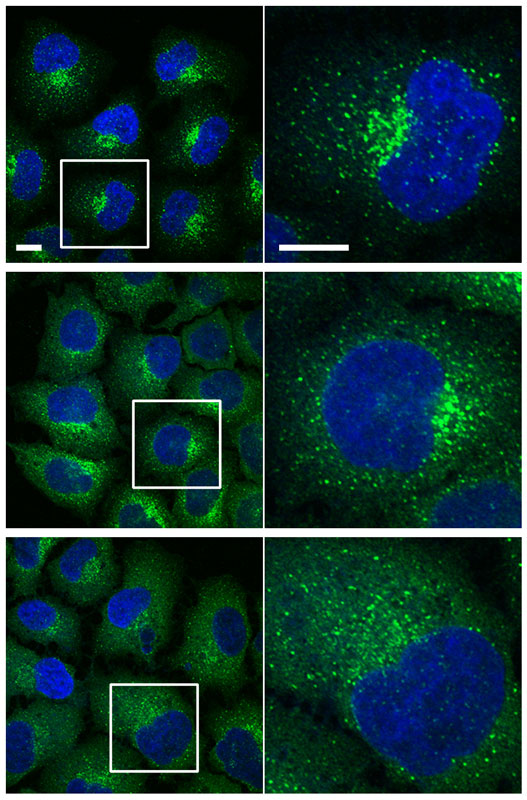
Export extravaganza

Scientists at the European Molecular Biology Laboratory (EMBL) in Heidelberg, Germany, have conducted the first comprehensive census of human cells’ export workers. In a study published online today in Nature Cell Biology, they found an unexpected variety of genes involved in transporting molecules to the cell membrane and beyond.
Using a combination of genetics and sophisticated microscopy, Rainer Pepperkok and colleagues systematically silenced each of our 22 000 genes, and observed to what extent this affected the cell’s ability to transport a protein. They found that 15% of human genes somehow influence this transport network – known as the secretory pathway – including genes that provide a link to other events in and around the cell.
Their findings suggest, for instance, that our cells evolved a complex strategy for adapting to changes in their environment. When a cell senses a growth factor called EGF in its surroundings, a protein on the cell membrane aptly named the EGF receptor is taken from the membrane into the cell, starting a chain reaction that ultimately leads the cell to divide, and during which the EGF receptor is degraded. The EMBL scientists have now found that the process also triggers an increase in activity at the early steps of the secretory pathway to transport newly synthesised EGF receptor back to the membrane, where it will be needed again.
Next, the scientists would like to tease out how mechanisms like sensing the environment, controlling genes and transmitting signals are connected to transporting molecules to the membrane, in an effort to better understand how cells work as whole.
The study’s data is freely available to the scientific community at www.mitocheck.org, alongside results of previous screens focused on essential cellular functions like cell division. Pepperkok is working with Jan Ellenberg at EMBL in Heidelberg and Alvis Brazma at EMBL’s European Bioinformatics Institute (EMBL-EBI) in Hinxton, UK, to develop a public repository for such image-based screens, which others will be able to turn to when studying the function of human genes.The work was carried out in collaboration with Jeremy Simpson, now at University College Dublin, Ireland.
Source article
Simpson, J.C., Joggerst, B., Laketa, V., Verissimo, F., Cetin, C., Erfle, H., Bexiga, M.G., Singan, V.R., Hériché, J., Neumann, B., Mateos, A., Blake, J., Bechtel, S., Benes, V., Wiemann, S., Ellenberg, J. & Pepperkok, R. Genome-wide RNAi screening identifies human proteins with a regulatory function in the early secretory pathway. Nature Cell Biology, Advance Online Publication 3 June 2012.
DOI: 10.1038/ncb2510.
Article abstract
The secretory pathway in mammalian cells has evolved to facilitate the transfer of cargo molecules to internal and cell surface membranes. Use of automated microscopy-based genome-wide RNA interference screens in cultured human cells allowed us to identify 554 proteins influencing secretion. Cloning, fluorescent- tagging, and subcellular localisation analysis of 179 of these proteins revealed that over two-thirds localise to either the cytoplasm or membranes of the secretory and endocytic pathways. The depletion of 143 of them resulted in perturbations in the organisation of the COPII and/or COPI vesicular coat complexes of the early secretory pathway, or the morphology of the Golgi complex. Network analyses revealed a so far unappreciated link between early secretory pathway function, small GTP-binding protein regulation, actin cytoskeleton organisation and EGF-receptor- mediated signalling. This work provides an important resource for an integrative understanding of global cellular organisation and regulation of the secretory pathway in mammalian cells.


